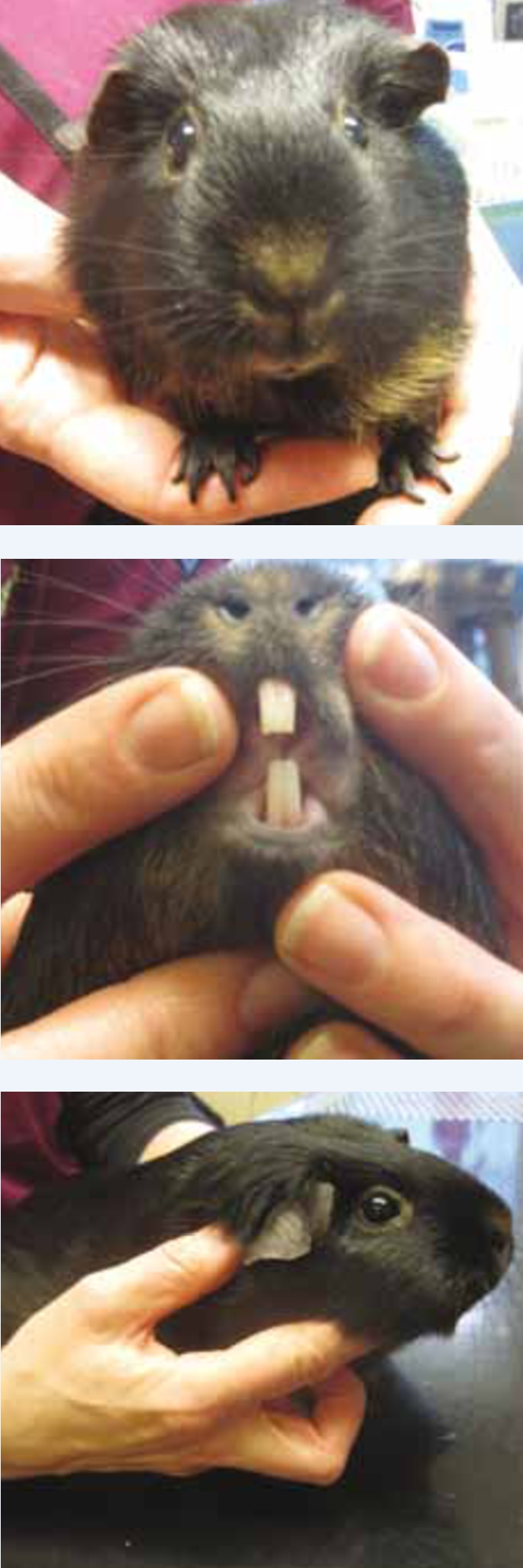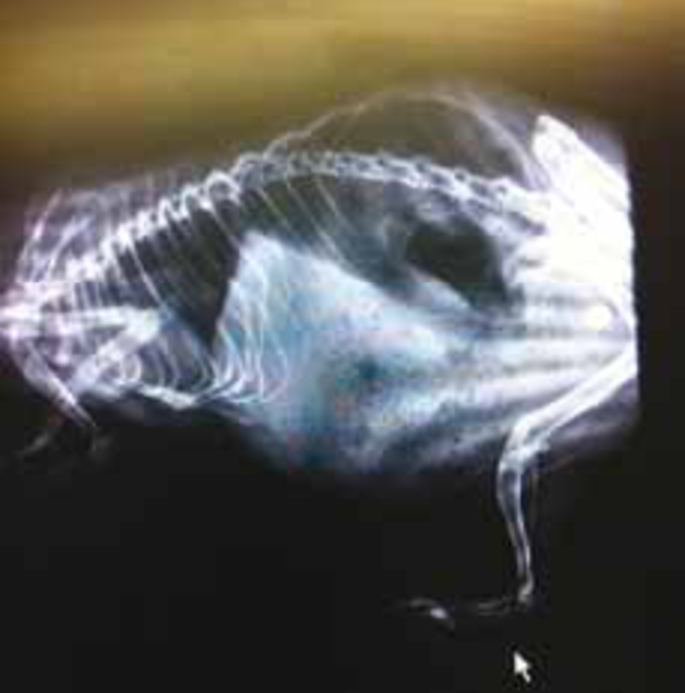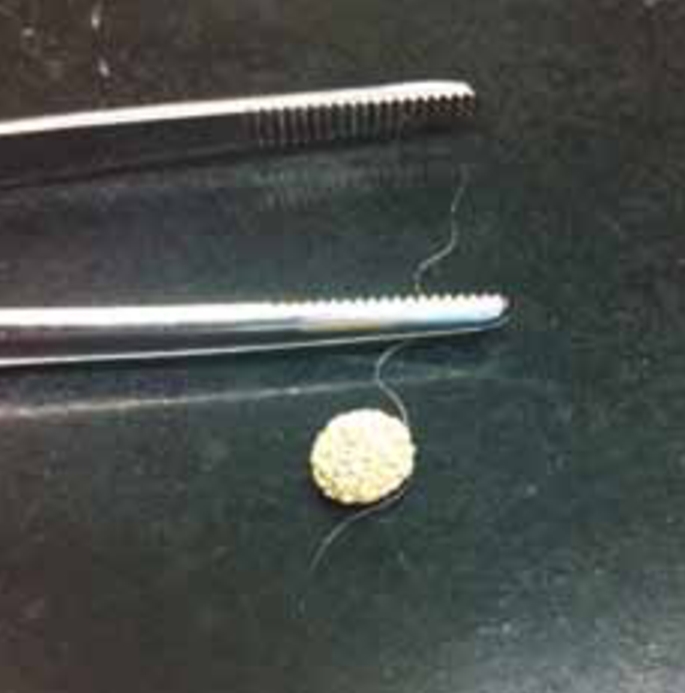Rabbits are anatomically and physiologically developed for a high fibre diet. Their teeth are designed for continuous wear from prolonged chewing, and their digestive process is perfectly suited for maximum nutrient absorption from low-nutrient vegetation. While it is possible for the rabbit to meet some nutritional needs with low fibre foods, the rabbit’s anatomy and physiology is such that longterm low dietary fibre levels can have detrimental effect on the rabbit’s health and wellbeing. As such, it is important that pet rabbits, and rabbits in a clinical environment are supported with adequate fibre levels and ample opportunities to chew.
Digestive anatomy, physiology and feeding behaviour in the rabbit
Rabbits are crepuscular animals, being more active during dawn and dusk and they feed primarily during these hours. Rabbits are well adapted to living in environmrnts with sparse nutritional resources so they are attuned to choosing the most nutritious and succulent part of a plant on which to feed. Like most herbivores, rabbits must consume a large quantity of vegetation in order to meet their nutritional demands, but compared with other monogastric herbivores, rabbits ingest a significantly larger volume of vegeta relative to their size. Part of the reason for their large appetite is their high surface to bodyweight ratio which subsequently requires a greater relative supply of energy. To meet energy needs, a rabbit eating a diet with a dry matter energy density of around 2300 kcal/ kg must eat at least 5–8% of its total bodyweight in feed each day (Jenkins, 1999).
Rabbits have developed a number of adaptations to deal with the physiological consequences of ingesting large volumes of vegetation. Each day, the rabbit spends a great deal of time chewing coarse fibres so it is no surprise that significant tooth wear occurs from masticatory abrasion. To avoid total tooth loss, the rabbit has aradicular hypsodont, or elodont, dentition which provides continuous eruption of tooth tissue from the root. As the teeth are constantly growing, overall health and wellbeing of the rabbit are critically dependent on dental attrition and this is facilitated by a diet high in coarse fibre.
The rabbit’s digestive tract is composed of a simple stomach and small intestine as well as a highly developed colon where hindgut fermentation takes place. Rabbits have the largest caecum of any mammal relative to their size, holding just under half of their total gastrointestinal (GI) volume, and comprising nearly a fifth of their total bodyweight (Portsmouth, 1977; Stevens and Hume, 1995). During active feeding times, the fusus coli, a muscular area dividing the proximal and distal colon, sorts large and small fibres, sending small particles back into the caecum for fermentation and assembling large fibres in the lumen of the proximal colon where they are dehydrated and excreted as dry faecal pellets.
During inactive non-feeding periods, the rabbit’s intestinal motility decreases and fermented digesta is expelled from the caecum into the proximal colon where it is formed into soft faecal pellets which the rabbit consumes directly from the anus as they are passed. After ingestion, these caecotrophs are stored in the fundus of the stomach where they slowly dissolve and are released into the small intestine where nutrients are absorbed (Marounek et al, 1995; Stevens and Hume, 1995; de Blas & Wiseman, 2010). It is by this two-stage digestive process that the rabbit gains the benefit of absorbing significant amounts of nutrient from the vegetation that it eats.
Fermentation of fibre within the caecum provides many rich nutritional resources for the rabbit by producing physiologically active by-products including volatile fatty acids and microbial proteins. Beneficial caecal microflora include a diverse range of species such as Bifidobacterium, Clostridium, Bacteroides and Enterobacter and healthy populations of these species rely strongly on a regular diet of fermentable fibre (Padilha, et al, 1999; de Blas and Wiseman, 2010).
Fibre as a nutrient and its role in maintaining gut motility
Different types of fibre play different roles in maintaining the rabbit’s GI health. Dietary fibre is produced by plants and is composed of polysaccharides similar in structure to carbohydrates. Fibre is generally classified according to its solubility, or its ability to absorb water. For example, insoluble fibre does not absorb much water and is metabolically inert but it is beneficial in that it softens and bulks up the stool and increases transit time through the intestine so that nutrients can be better absorbed. In contrast, soluble fibre does not always have a fibrous structure but it does absorb varying amounts of water. Some types of soluble fibre form a viscous or gelatinous compund that is easily fermented by beneficial microbes. Nutritionally, both soluble and insoluble fibres are essential for good digestion and each affects digestion in different ways (de Blas, 1992).
Long insoluble fibres move through the digestive tract much faster than fine soluble fibres and it is the process of separation between soluble and insoluble fibres that helps to maintain GI motility in rabbits (Ruckebush and Hornicke, 1977; de Blas and Wiseman, 2010). Rabbits are only able to digest around 14% of the insoluble fibre within most forages compared with other hind-gut fermentors like horses that are able to digest up to 40%, but the rabbit is able to extract a much higher amount of nutrients from the vegetation through fermentation and ingestion of caecotrophs (Cheeke, 1987).
The importance of gut motility
Maintenance of GI function relies on reliable transit of digesta and this is highly dependent on a number of factors (Table 1). The rabbit’s cyclic eating pattern provides a mechanism for caecotrophy to take place and this recycling of beneficial microbiota is essential for caecal efficiency. Fermentation allows nutrient extraction and high fibre levels keep motility high.
Table 1. Some factors that drive normal gastrointestinal motility
| Cyclic eating pattern |
| High insoluble fibre ingestion |
| Caecotrophy |
| Feed particle size distribution |
The sorting process of insoluble and soluble fibres within the proximal colon helps to maintain GI motility and there is evidence that fibre particle size plays a key role in this process (Gidenne, 2000). As a result, it may be important to consider ensuring rabbits get access to varying fibre lengths to ensure a particle size differential that will have a beneficial effect on GI motility.
Insufficient fibre levels can cause decreased GI motility as well as reduced viability of microflora (Table 2). Excessive protein or carbohydrate levels can have a similar effect and as such, they need to be carefully controlled (Cheeke, 1994).
Table 2. Physiological effects of low dietary fibre in the rabbit
| Consequences of reduced viability of caecal microflora | Consequences of gastrointestinal hypomotility |
|---|---|
| Decreased intestinal motility | Diminished microbial action |
| Intestinal malabsorption | Intestinal malabsorption |
| Diminished immune response | Trichobezoars |
| Intestinal pH changes | Constipation |
| Intestinal gas build up | Intestinal gas build up |
| Proliferation of pathogenic bacteria within the caecum | Hepatic lipidosis |
Since GI hypomotility can pose a serious health threat to rabbits, it is a significant clinical concern and there are a number of reasons that it can occur (Table 3). To combat these problems and help ensure effective prevention and treatment, it is vital to ensure that adequate nutrition is available (Harcourt-Brown, 2002; Rees Davies, 2006).
Table 3. Some causes of gastroinstestinal hypomotility
| Stresspolyphagia |
| Pain |
| Dental problems |
| Dehydration |
| Anorexia/inability to eat or lack of appetite |
| Insufficient dietary fibre |
| Intestinal blockage |
The role of fibre in maintaining healthy dentition
Like many types of rodents, healthy dentition in the rabbit relies on continual wear from chewing on coarse materials. Rabbits have aradicular dentition which provides continual eruption of teeth from the roots to replace tooth tissue worn away from masticatory abrasion. The adult rabbit has 28 teeth consisting of incisors, premolars and molars. Like most herbivores, the premolars and molars are grouped together forming a flat occlusal plane with ridges used to grind coarse fibrous vegetation (Verstraete and Osofsky, 2005).
In general, rabbits are adapted to spend a great deal of their time each day browsing and chewing their food. Caged rabbits may lack opportunities for natural feeding behaviours so it is important that environmrntal enrichment is provided by way of ample opportunities to chew fibrous foods like hay and high-fibre pelleted diets.
Nutrition for pet rabbits
A high fibre diet is essential to the rabbit’s wellbeing. Research suggests that the minimum dietary fibre requirement for rabbits is around 20–25% and studies show that diets with less fibre can result in reduced GI motility, prolonged retention of digesta within the caecum, decreased formation of caecotrophs and a higher incidence of enteritis and diarrhoea (Cheeke, 1994; Jenkins, 1999). Without continual wear from chewing, malocclusion can develop and can lead to a number of oral problems (Table 4) as well as serious health consequences for the rabbit including anorexia and GI hypomotility (Verstraete and Osofsky, 2005).
Table 4. Oral pathology that can occur from malocclusion
| Sharp tooth points/spikes |
| Distortion of the occlusal plane |
| Periapical changes |
| Apical elongation |
| Oral soft tissue lesions |
| Maxillofacial abscess |
When fibre is reduced, other nutrients will be present in a higher concentration and this can also be detrimental for the rabbit (Gutierrez et al, 2002). As in many other animals, high levels of carbohydrates can provide surplus energy and may increase the chance of obesity. Carbohydrates are an easily accessible energy source and within the caecum can produce a rapid proliferation of Clostridium spp and subsequently lead to diarrhoea and other digestive upsets. Studies show that high protein levels act in a similar way so levels should be carefully controlled (Cheeke, 1994; Gidenne and Fortun-Lamothe, 2002). With what we know now about maintaining GI motility, it is not just enough to provide a fibrous diet, it is also essential that the diet include a high proportion of fermentable insoluble fibre as well as a variation in fibre particle size (Brooks, 1997; de Blas and Wiseman, 2010). Dietary plans will vary in rabbits depending on their life stage, health, and reproductive status but for most animals, quality pasture hay provides a good nutritional foundation. Supplementing the diet with fresh vegetables and a premium pelleated concentrate can help ensure that all nutritional needs are met, however, not all concentrates are created equal so it is important to seek out a diet that more closely mimics the natural diet.
Guinea pig case study (Monoforage)Signalment‘Herbie’ is a 5-year-old intact female guinea pig. She weighs 1.4 kg and she is slightly overweight. She is fed on a commercial muesli-type diet and lives in an outside hutch with access to a small run. Herbie was presented to the surgery with a complaint of apparent pain on urination. There had been a single episode of blood being noticed in the urine.Examination and diagnostic work-up Herbie underwent a thorough physical examination (including a dental exam) (photo 1) and was admitted for radiography. The initial radiographs were taken with Herbie conscious, using a small cardboard box to restrain her safely on top of the x-ray table. The initial x-ray showed a possible urinary stone, so Herbie was anaesthetized using isofluorane in an induction chamber, and well positioned x-rays were taken (photo 2).
Photo 1. The patient was given a thorough physical examination.

Photo 2. The patient was anaesthe and x-rays were taken.
DiagnosisHerbie was diagnosed with a bladder stone.TreatmentHerbie underwent a cystotomy to remove the stone from the bladder (photo 3).
Photo 3. A cystotomy was performed to remove a stone from the bladder..
Nursing care requiredHerbie received 7 mg of marbofloxacin, 0.7 mg or meloxicam and 15 ml of lactated Ringer’s solution (subcutaneously) while she was under anaesthesia. When she awoke, she still seemed to be in pain so additional pain relief (buprenorphine 0.001 mg) was given by injection. Herbie was not observed to eat once she was able to move around, so support feeding was given (20 ml of Supreme Recovery Plus) by syringe. This was accepted well, and soon after Herbie appeared to take interest in some of the fresh food she had been offered. Overnight Herbie ate pellets and also passed droppings. Her comfort levels appeared good, and she was discharged from the surgery with oral marbofloxacin and meloxicam to be administered at home. Because Herbie’s condition was one that has the potential to recur, dietary changes were advised. Rather than offering a muesli type diet that allowed her to select only the bits that she liked, a pelleted diet was recommended. In this case a diet such as Supreme Fibafirst Monoforage is an ideal choice because it supports the digestive and immune health of the guinea pig, while satisfying the nutritional requirements. Good nutrition is the key to recovery after surgery and for long-term urinary tract health.Nursing follow upOne week post operatively, Herbie was eating well, but had lost a little weight. This was monitored over the next 4 weeks and her weight stabilized at a healthy 1.1 kg. The weight loss was attributed to the change in diet, especially the reduction in sugars due to the Fibafirst food. Herbie recovered well from the surgery, and her wound appeared well healed at day 14, when the sutures were removed. Currently (9 months post operatively) Herbie has had no recurrence of her bladder stones and no evidence of blood in her urine, or pain on urination.
As with dogs and cats, a great deal of research is going into the production of premium rabbit diets and there are a number of new diets that are addressing the rabbit’s unique nutritional needs. This year Supreme Petfoods came out with a new Mono-forage® formulation producing the first range of rabbit pellets with greater than 25% fibre content. The Monoforage® formula is innovative in that it contains long fibres to promote extended chew times as well as varied particle size to promote normal GI motility. For rabbits that are unable or unwilling to eat enough hay, these pellets are ideal and very closely mimic the rabbit’s natural diet by supporting the rabbit’s cyclic digestive process and by providing environmental enrichment with ample opportunities to chew. The Fibafirst® Monoforage formulation is available as a health maintenance diet for healthy rabbits and guinea pigs (Table 5).
Table 5. Fibafirst® Monoforage® foods for rabbits and guinea pigs
| Fibre | Special features | |
|---|---|---|
| Fibafirst® for rabbits | 30% | Nutritionally complete with added vitamins and minerals Beneficial long fibres to extend chew time and increase dental wear Enhanced environmental enrichment through extended chew time |
| Fibafirst® for guinea pigs | 22% | Nutritionally complete with added vitamins and minerals Added Vitamin C Beneficial long fibres to extend chew time and increase dental wear Enhanced environmental enrichment through extended chew time |
For rabbits that are hospitalized, preventing GI hypomotility is a significant concern as they are frequentiy undergoing painful procedures, anaesthesia or are recovering from illness and reluctant to eat. It can be challenging to provide enough fibre to promopte normal GI motility while also addressing additional concerns relating to the rabbit’s health status. Fortunately the Monoforage formulation is also available in a range of new veterinary diets for rabbits and guinea pigs providing very high fibre levels in addition to added nutrients that support specific medical conditions (Table 6).
Table 6. VetCare Plus Rabbit Diets
| Fibre | Special features | |
|---|---|---|
| Weight Management Formula | 34% | 12% protein Low energy content No need to limit intake, although weight should be monitored Green tea — to help stimulate metabolism and promote energy usage Fenugreek — enhances palatability and may assist in the reduction of fatty deposits |
| Digestive Health Formula | 32% | High in natural prebiotics to help support the digestive system Peppermint — to help soothe and relax the digestive system Fennel — to gently help prevent the likelihood of digestive bloat Chamomile — to help ease diarrhoea and reduce anxiety and stress |
| Urinary Tract Health Formula | 28% | Low calcium (0.5%) Added vitamin C (500 mg/kg) Cranberries and billberries — natural antioxidents Echinacea — to help support the immune system and fight infection Dandelion — a gentle diuretic to stimulate routine renal function |
Conclusion
Dietary fibre provides many benefits to rabbit health. The rabbit’s continually growing teeth require regular wear from chewing on fibrous vegetation and the rabbit also receives environmental enrichment from chewing for long periods of the day. Fibre promotes effective intestinal motility and ensures the rabbit is able to ferment soluble fibre in order to extract the maximum amount of nutrients. Feeding healthy pet rabbits, and rabbits that are hospitalized, requires attention to their unique dietary needs and the new exceptionally high fibre premium foods by Supreme Petfoods provide a convenient and natural diet that promotes optimum rabbit health and wellbeing
Key Points
- Fibre is critical for maintaining gut health in rabbits.
- Fibre is essential for increasing tooth abrasion for a rabbit’s good dental health.
- Fibre increases chew time which improves psychological wellbeing.
- Optimal long-term diets for pet rabbits contain a high amount of fibre.
- It is important to choose commercial diets with a sufficient amount of fibre
- Supreme’s new Monoforage® formulation is the first range of rabbit pellets with greater than 25% fibre content.

